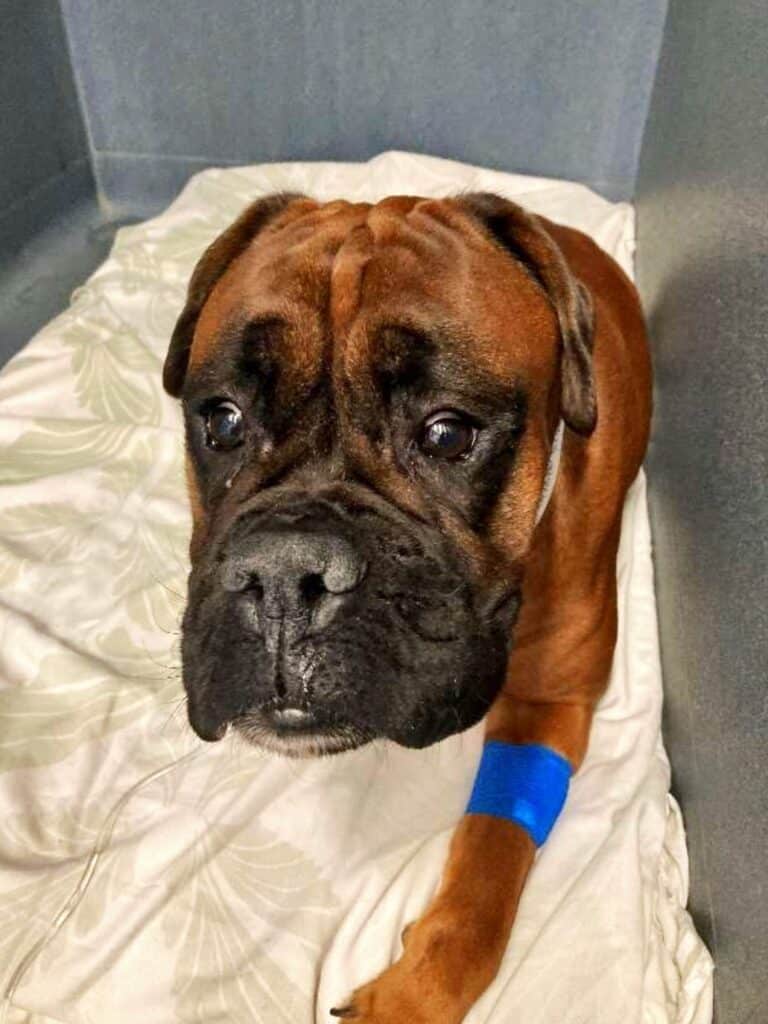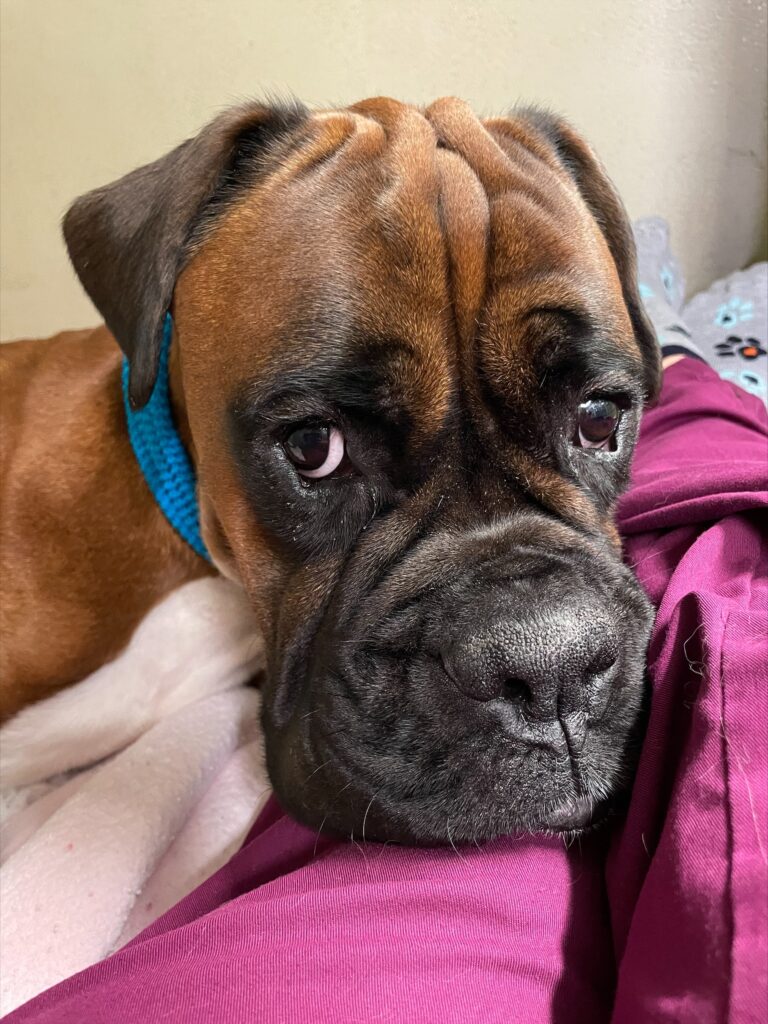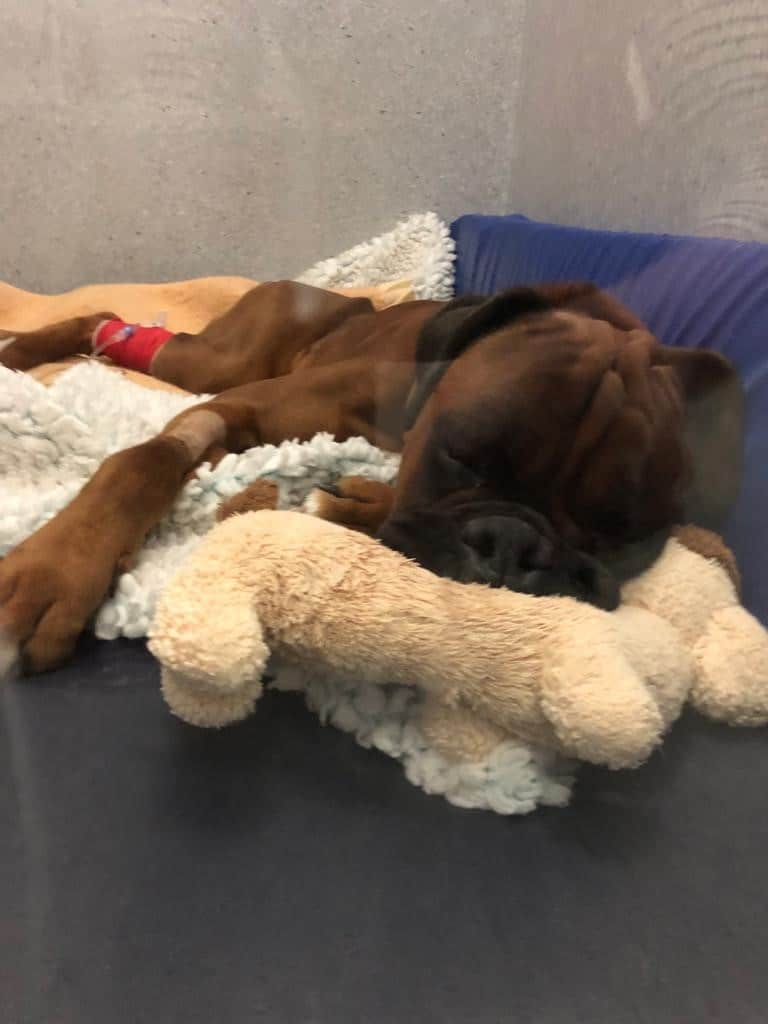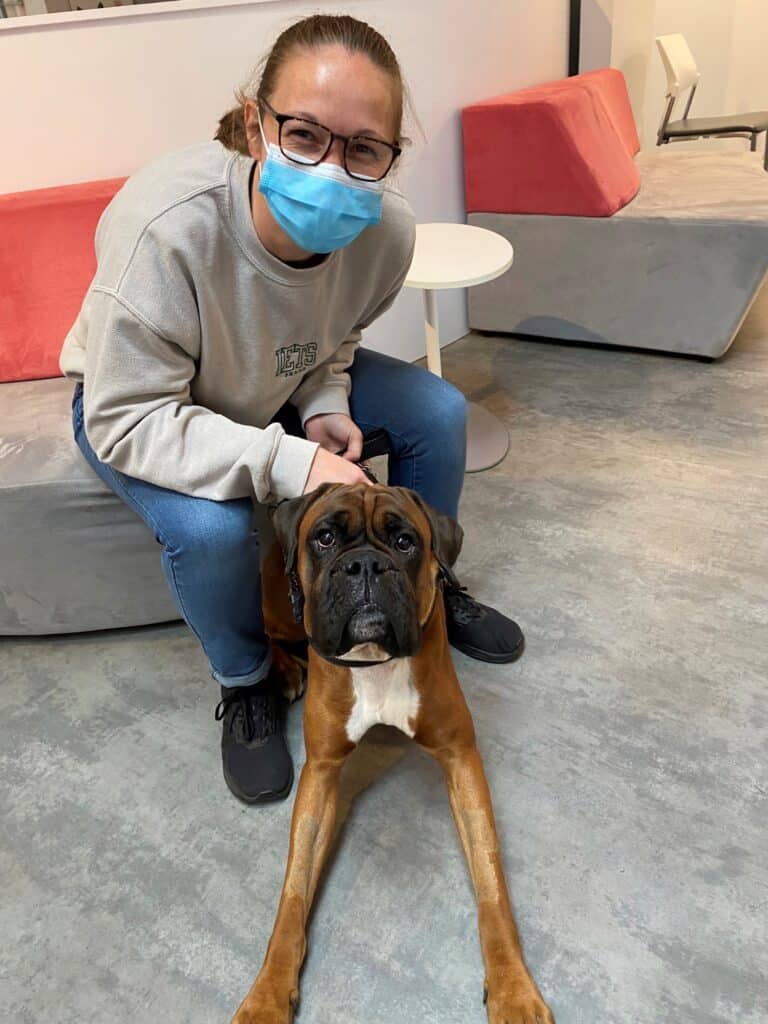Otis the legend…
Otis, a one-and-a-half-year-old boxer was referred to us at Anderson Moore in March 2022 for an emergency investigation of his symptoms. For a few days before his owners said he was vomiting and had diarrhoea and that he was interested in eating but was dropping food from his mouth and seemed unable to swallow normally.
Since then, he deteriorated rapidly, developing lethargy, anorexia and appeared to be vacant and uninterested. When we lifted him, his body and limbs seemed rigid, he had a mild stertor (a respiratory noise characterised by snoring) and was reluctant to open his mouth.
Bryn, one of our small animal internal medicine Residents performed a physical exam. Otis seemed alert and responsive but reluctant to stand and walk so was checked by our neurology team, he also had a marked tightening of his facial muscles. Bryn noticed over the right digit on his hind paw-some mild swelling and a small, healing wound that didn’t seem painful when it was touched. Otis’ back legs were stiff and facial expression showed possible neurological abnormalities. These signs on top of the recent wound were highly suggestive of a Tetanus infection.

Tetanus is caused by neurotoxins released by the bacteria Clostridia tetani. This bacterium originates from the soil and can enter the body via open wounds or penetrating injuries. Diagnosis is generally based on a consistent physical examination and history. Clinical signs can develop three to 18 days after injury. Tetanus can be graded in its severity into four classes, with a worse prognosis associated with higher classes. Otis presented with class II disease. The prognosis for dogs who remain ambulatory (able to walk) is excellent but is more guarded for dogs who become recumbent, and cases can take one to two weeks to reach maximum severity. Aspiration pneumonia is a significant cause of morbidity and mortality.
We recommended admitting Otis to the hospital to start treatment immediately and for further monitoring.

We initiated treatment immediately with fluid therapy, assisted feeding and antibiotic therapy. Because we had diagnosed him at the early stages of the disease, we felt that he could possibly benefit from tetanus antitoxin (TAT).
Otis was unable to swallow food, so a nasogastric feeding tube was inserted to continue his nutrition. We also started pain relief and muscle relaxants due to his muscle spasms and dysuria (difficulty urinating). Due to the risk of potential urinary retention, we inserted a urinary catheter. This also allowed us to monitor his urine output and minimise the need for him to have to urinate as he was unable to stand.

Sadly, Otis’ symptoms progressed further; he became recumbent and began to regurgitate his food and developed upper respiratory tract obstruction because of an accumulation of saliva/mucus and most likely laryngospasm. To manage these complications, Allie from our soft tissue surgery team inserted a temporary tracheostomy tube, as well as an oesophageal feeding tube. He reached grade III level of his disease due to his airway obstruction.
Otis required intensive care and hospitalisation, so his care was overseen by Adam our Specialist in emergency and critical care. Tetanus can cause noise and light sensitivity; so, Otis needed a dark, quiet environment with minimal stimulation. We placed cotton wool in his ears to reduce noise sensitivity and coordinated his treatments at set times to allow minimal handling. Our nursing care included turning him every three to four hours. Prolonged periods of lying on his side would have caused pressure to his lungs. This pressure decreases the amount the lung can inflate and can lead to atelectasis (temporary collapse of the lung). Another potential complication for recumbent patients is the development of decubital ulcers (bed sores), therefore we padded any bony prominences, placed padding between his legs and provided soft, comfortable bedding around him. It was important that his tracheostomy tube was not restricted when he is lying down, so we kept his head and neck supported and extended.
The tracheostomy tube requires nebulising and suctioning every two to four hours to prevent secretions from drying up and blocking the tube. The nursing team had to monitor him regularly for noisy breathing that would indicate a secretion build-up, increased the chance of an airway resistance or obstruction. The tracheostomy tube also needed replacing every 24 hours. His respiratory rate was monitored closely along with his oxygen saturation and temperature. Hyperthermia can be a potential complication due to the muscle contractions. It was essential that Otis remained calm and cool whilst it was in place.
Otis’ urinary catheter required cleaning and emptying every four hours. And the nursed monitored his urine output closely to ensure he was adequately hydrated. His fluids were adjusted based on his hydration status, which the team monitored by checking his body weight, urine output and regular blood sampling.
Otis was a high risk for a hospital-acquired infection due to the number of indwelling devices he had placed and the length of his hospitalisation. Therefore, all indwelling devices were handled aseptically to reduce this risk. However, he did develop a urinary tract infection, which was treated with the appropriate antibiotics.
Otis required oral and ocular care due to his inability to lubricate these areas. This was to prevent mouth and eye ulcers from developing. The nursing team administered his medications, monitored his vital parameters, and provided assisted feeding via his oesophagostomy tube. He tolerated his tube feeding well, however, he continued to lose weight, which we addressed by increasing his caloric intake. He continued to be tube fed for three weeks for fear of inducing aspiration if he was fed by his mouth. Even though he was very keen to eat by this point, it was in his best interest to continue assisted feeding.
For a brief period, he was showing possible seizure activity (associated with very guarded prognosis) and was treated with medication, they were more likely tetanic spasms and/or abnormal REM sleep activity, which has been associated with tetanus, and it soon stopped so we stopped the medication.
Otis’ mobility started to improve after two weeks, he was able to maintain a sitting position, was able to stand unassisted, and his ambulation was improving. It was joyous to see him walk and even try to run! He was able to yawn, keen to play and even give kisses!

The physiotherapy team introduced a range of movement exercises to help to minimise his joint stiffness, reduce the discomfort associated with his muscle rigidity and prevent muscle wastage.
The tracheostomy tube was removed after 12 days. There were several attempts to remove his urinary catheter, however, he was still having difficulty urinating. After 22 days, the urinary catheter was finally removed, and he was able to produce small amounts of urine. The nursing team were ecstatic when he first urinated by himself after the days and night of care they had given him. He still required bladder expression to help him be fully empty and needed medication to help urethral sphincter relaxation. He remained in hospital until his urination improved and he was able to be fed by is mouth without any complications.
After four weeks in the hospital with us in Hampshire receiving intensive nursing and capturing the team’s hearts, they could finally feed him! He ate keenly and showed no signs of dysphagia or regurgitation. He loved to play with toys and enjoyed his walks around our Woodland Walk. He became a celebrity amongst our team. We were so pleased when he was discharged on the in April. He was a wonderful patient to nurse, and it was extremely rewarding to see him get better.

The nurses involved in Otis’ care:
Day nurses: Eden Geary, Abi Holder, Emma Howell-Jones, Nikki Hammond, Jil Pratt, James Tattersall, Katie Simmonds, Claire Allen, Cara Anderson, Rachael Houghton, Becky Ward, Leila Hallaji, Charley Warren, Jo Bealey and Sarah Parish.
Twilight nurses: Anna Brown, Jess McKirgan and Emily Seymour.
Night nurses: Sarah Guppy, Ellen Martin, Vicky Crichton, Sarah Frampton, Lindsay Clark, Amy Rawlinson and Lizzie Cronin.